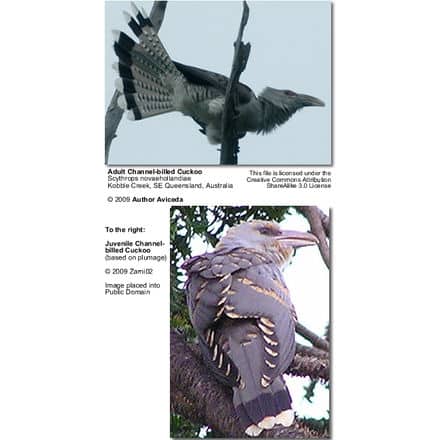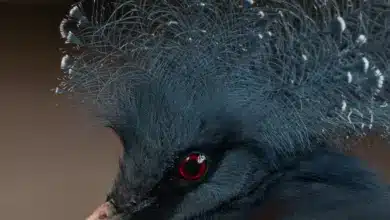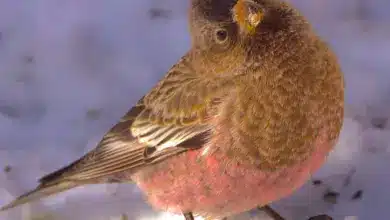Channel-billed Cuckoos
The Channel-billed Cuckoos (Scythrops novaehollandiae) is a species of cuckoo in the Cuculidae family. It is monotypic (one single species) within the genus Scythrops. The species is the largest brood parasite in the world and the largest cuckoo.
It is found in Australia, Papua New Guinea, and Indonesia; additionally, it is vagrant in New Caledonia and New Zealand. The species is migratory over part of its range. There are three subspecies, one migratory, the other two resident.
It inhabits subtropical or tropical moist lowland and mangrove forests.
The species is listed as least concern by the IUCN.
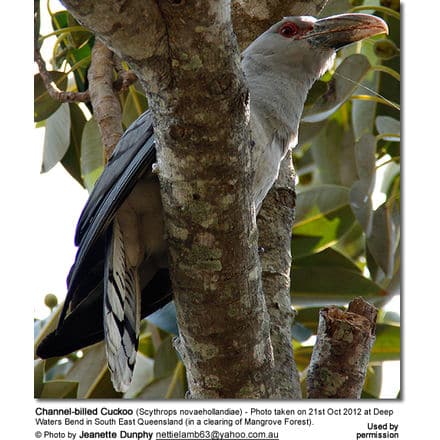
Taxonomy
The only member of the genus Scythrops, the Channel-billed Cuckoo was first described by ornithologist John Latham in 1790. Its generic name is derived from the Ancient Greek skuthro-/??????- ‘angry’ or ‘sullen’, and ops/?? ‘face’, ‘eye’ or ‘countenance’. The specific epithet novaehollandiae means of New Holland, hence Australian.
There are three subspecies:
- the nominate Scythrops novaehollandiae novaehollandiae of Australia, New Guinea and the Moluccas (Maluku Islands)
- Scythrops novaehollandiae fordi in Sulawesi, and
- Scythrops novaehollandiae schoddei in the Bismarck Archipelago.
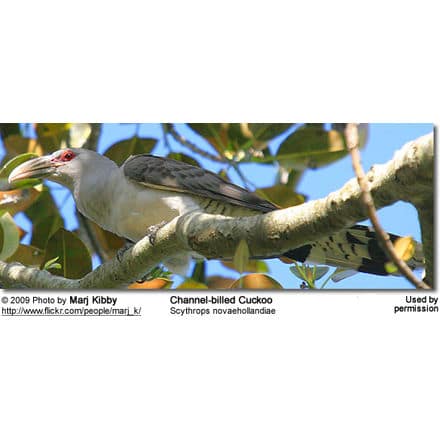
Description
The Channel-billed Cuckoo is the world’s largest cuckoo, measuring between 58-66 cm (23–26 in) long and weighing between 550-930 grams (19.4–32.8 oz).
The bill is bi-colored, with a grey base becoming straw-colored at the tip. The bill is large slightly curved and reminiscent of the bills of hornbills; in fact, the bird is sometimes erroneously referred to as a hornbill.
The plumage of the adult is pale grey on the head, chest, belly, and back, becoming paler and barred lower down on the belly.
The wings are darker grey with dark tips on the feathers. The tail is dark grey on top and barred underneath with a black band and white tip at the end.
The feet and legs are black, and the eye is surrounded by prominent red skin. The Channel-billed Cuckoo is a strong flier, with a distinctive, almost hawk-like cruciform flight silhouette.
In flight, the wingspan is around 1 m, with the wings held stiffly.
There is some sexual dimorphism (visual physical differences between the sexes) in both plumage and dimensions, with the female having a smaller bill and paler, more barred undersides.
The juvenile is similar to the adult but has pale tips to the feathers of the wings, and the rest of the plumage is buff instead of pale grey. The bill is less massive and dirty pink in colour, and the skin around the eye is not red.
Distribution and movements
The Channel-billed Cuckoo has a widespread distribution across northern and eastern Australia, New Guinea, the Bismarck Archipelago, and the islands of eastern Indonesia as far west as Sulawesi.
The species is a permanent resident in the Bismarck Archipelago, Flores, and Sulawesi. Elsewhere within its range, it is migratory. Birds breeding in Australia range from northeastern West Australia through the Northern Territory and Queensland down into eastern New South Wales down as far as Sydney.
A few stragglers reach the eastern tip of Victoria but are not thought to breed there. Vagrant birds have reached New Zealand and New Caledonia.
After the breeding season, in March and April, birds breeding in Australia begin to migrate northwards to their wintering grounds in New Guinea and Indonesia. Birds breeding in New South Wales begin leaving earlier, in February and March.]
The migration route is across the Torres Strait, traveling in individually or in small groups. From New Guinea, they migrate across the nearby islands as far as Timor and the Moluccas. It is not known if the species breeds in New Guinea, as some birds are present there all year. Migrating Channel-billed Cuckoos begin to return to Australia in October.
Diet
Unusually for cuckoos, which take insect prey, but like the closely related koels, fruit forms a major part of the diet of Channel-billed Cuckoos.
Fruits taken include those of several species of Ficus figs, the seeds of eucalyptus trees, the fruits of trees in the family Loranthaceae as well as the fruits of the introduced Black Mulberry.
Also taken are insects, including beetles, butterflies, and grasshoppers, and the nestlings and eggs of birds, including Apostlebirds, Magpie-larks, and Noisy Miners.
Birds typically feed in the canopy of large trees, sometimes in groups and occasionally with other fruit-eating birds such as Figbirds and cuckoo-shrikes.
Breeding behaviour
Channel-billed Cuckoos are brood parasites; instead of raising their own young, they lay eggs in the nests of other birds. They are thought to form pair bonds for the duration of a breeding season.]
Their mating behaviour has been described as involving calling and gift-giving, with the male presenting items of food such as insects to the female. Pairs also work together to aid the laying of eggs in host nests; the male will fly over the nest to provoke the nest occupants into a mobbing response, whereupon the female will slip into the nest and lay an egg.
Alternatively, the pair may work together by attacking an incubating bird, driving it off the nest, and allowing the female to lay.
The host species varies depending on the location; the most commonly targeted hosts are crows, currawongs, butcherbirds, and Australian Magpies. Several eggs can be laid in a single nest, sometimes by different females.
Often resembling those of currawongs and magpies (but not crows), the eggs vary in colour and pattern, measuring 48 x 32 mm. They can be a reddish- or yellowish-brown to dull white, with darker brown splotches.
The incubation period for this species is unknown. Upon hatching the chicks are altricial, being blind and naked. Unlike many other cuckoos, the chicks of the Channel-billed Cuckoo do not eject the other host eggs upon hatching or kill the host’s chicks, but these seldom survive as the cuckoo chick can monopolize the supply of food.
The chicks are fully feathered within four weeks and leave the nest to clamber about on the branches, although chicks are fed for several weeks by the host parents after fledging.
Relationship with humans
Channel-billed Cuckoos are often shy and retiring and are better known for their calls. In northern Australia their migration coincides with the beginning of the rainy season, leading to the species being given a range of colloquial names such as storm-bird, flood-bird, or rain-bird.
The fruigivorous habits of the species, coupled with its raptor-like appearance, have also resulted in it being known as the fig hawk.
The Channel-billed Cuckoo is not considered threatened by human activities, and as such is listed as least concern by the IUCN.
It has benefited from human activities; along with the Australian Koel its numbers have increased in some parts of its range due to increases in host species caused by extensive planting of gardens around Australian cities

